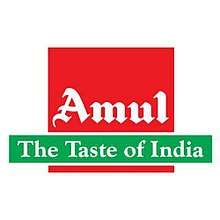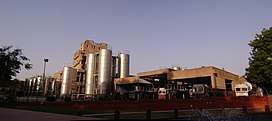Amul
Amul, is an Indian dairy cooperative society, based at Anand in the state of Gujarat.[3] Formed in 1946, it is a cooperative brand managed by a cooperative body, the Gujarat Co-operative Milk Marketing Federation Ltd. (GCMMF), which today is jointly owned by 3.6 million milk producers in Gujarat.[4] Amul spurred India's White Revolution, which made the country the world's largest producer of milk and milk products.[5]
 | |
| Cooperative Distribution Apply +91-9330209633 society | |
| Industry |
|
| Founded | 1946 |
| Founder | Tribhuvandas Patel |
| Headquarters | Anand, Gujarat, India |
Area served | Worldwide |
Key people | Rupinder Singh Sodhi (managing director)[1] |
| Revenue | |
Number of employees | 1000 (Marketing Arm) 3.6 million (Milk producing members)[2] |
| Website | www |
Amul was spearheaded by Tribhuvandas Patel under the guidance of Sardar Vallabhbhai Patel. As a result, Kaira District Milk Union Limited was born in 1946 (later renamed to Amul). Tribhuvandas became the founding chairman of the organization and led it until his retirement in 70s. He hired Dr. Verghese Kurien in 1949. He convinced Dr. Kurien to stay and help with the mission. Under the chairmanship of Tribhuvandas, Dr. Kurien was initially the general manager and helped guide the technical and marketing efforts of Amul. Dr. Kurien was the chairman of Amul briefly after Tribhuvandas Patel died in 1994.
Kurien, founder-chairman of the GCMMF for more than 30 years (1973–2006), is credited with the success of Amul's marketing.[6] Amul has ventured into markets overseas.
History

Amul cooperative registered on 19 December 1946 as a response to the exploitation of marginal milk producers by traders or agents of n the small city distances to deliver milk, often went sour in summer, to Polson. The prices of milk were arbitrarily determined. The government had given monopoly rights to Polson to collect milk from Kaira and supply it to Mumbai city.[7][8]
Angered by the unfair trade practices, the farmers of Kaira approached Sardar Vallabhbhai Patel under the leadership of local farmer leader Tribhuvandas K. Patel. He advised them to form a cooperative (Kaira District Co-operative Milk Producers' Union) and supply milk directly to the Bombay Milk Scheme instead of Polson (who did the same but gave them low prices).[9] He sent Morarji Desai to organise the farmers. In 1946, the milk farmers of the area went on a strike which led to the setting up of the cooperative to collect and process milk.[8] Milk collection was decentralized, as most producers were marginal farmers who could deliver, at most, 1–2 litres of milk per day. Cooperatives were formed for each village, too.[10] By June 1948, the KDCMPUL had started pasteurizing milk for the 'Bombay Milk Scheme'. Under the selfless leadership of Tribhuvandas Patel, in 1973, Amul celebrated its 25th Anniversary with Morarji Desai, Maniben Patel and Verghese Kurien.
The cooperative was further developed and managed by Dr. Verghese Kurien with H.M. Dalaya. Dalaya's innovation of making skim milk powder from buffalo milk (for the first time in the world) and a little later, with Kurien's help, making it on a commercial scale,[11] led to the first modern dairy of the cooperative at Anand, which would compete against established players in the market.
The trio's (T. K. Patel, Kurien and Dalaya's) success at the cooperative's dairy soon spread to Anand's neighbourhood in Gujarat. Within a short span, five unions in other districts – Mehsana, Banaskantha, Baroda, Sabarkantha and Surat – were set up, following the approach sometimes described as the Anand pattern.[8]
In 1970, it spearheaded the White Revolution of India. To combine forces and expand the market while saving on advertising and avoid competing against each other, the Gujarat Co-operative Milk Marketing Federation Ltd., an apex marketing body of these district cooperatives, was set up in 1973. The Kaira Union, which had the brand name Amul with it since 1955, transferred it to GCMMF.[12]
In 1999, it was awarded the "Best of all" Rajiv Gandhi National Quality Award.[13]
Technological developments at Amul have subsequently spread to other parts of India.
The GCMMF is the largest food products marketing organisation of India. It is the apex organisation of the dairy cooperatives of Gujarat. It is the exclusive marketing organisation for products under the brand name of Amul and Sagar. Over the last five and a half decades, dairy cooperatives in Gujarat have created an economic network that links more than 3.1 million village milk products with millions of consumers in India.
On September 30, 2018, Prime Minister Narendra Modi inaugurated Amul's chocolate plant in Mogar, Anand near their headquarters. The new plant has been built with an increased capacity of 1000 tons per month against the earlier 250 tons a month capacity. GCMMF has invested around Rs.300 Crores for this project. It is a fully automated production factory with minimal human intervention. [14]
UHT products and impact
Over the years, Amul has been witnessing growth in this portfolio, with the segment growing at 53%. Long life UHT products for urban populations, like Amul Taaza, which are packed in Tetra Pak cartons undergo UHT treatment to remove all harmful micro-organisms while retaining the nutrition in the milk. Amul sells around 4,00,000-5,00,000 litres of UHT milk and other value added products per day and forecasts this demand to continue growing at 25%. The UHT products have enabled Amul to position itself as the market leader in packaged milk segment without the need of maintaining cold supply chains.[15]
Advertising
In 1966, Amul hired Sylvester da Cunha, the managing director of the advertising agency as to design an ad campaign for Amul Butter. DaCunha designed a campaign as series of hoardings with topical ads, relating to day-to-day issues.[16] It was popular and earned a Guinness World Record for the longest running ad campaign in the world. In the 1980s, cartoon artist Kumar Morey and script writer Bharat Dabholkar had been involved with sketching the Amul ads; the latter rejected the trend of using celebrities in advertisement campaigns. Dabholkar credited chairman Verghese Kurien with creating a free atmosphere that fostered the development of the ads.[17]
Despite encountering political pressure on several occasions, DaCunha's agency has made it a policy of not backing down. Some of the more controversial Amul ads include one commenting on the Naxalite uprising in West Bengal, on the Indian Airlines employees strike, and one depicting the Amul girl wearing a Gandhi cap.[16]
In 2013, Amul tweeted a picture featuring the Amul butter girl, implying that 'freedom of choice' died in '2013', in opposition to the Supreme Court of India overruling the judgment of Delhi High Court and criminalising homosexuality again.[18]
On 17 October 2016, Amul butter girl celebrated 50 years when she first appeared in the topical ad titled "Thoroughbread". The ad showed a jockey holding a slice of bread during the horse race season in 1966. The impish Amul girl had appeared for the first time even before that, with Eustace Fernandez showed her offering bedtime prayers with a wink and a lick of lips, saying "Give us this day our daily bread: with Amul butter".[19]
Their Ad on Aagey Badhta Hai India had an excellent response from the audience. It basically spoke about how their Milk is seen as a household product with catchy tune associated to it. It has close to 2 Million views on YouTube.[20]
In popular culture
The establishment of Amul is known as White Revolution.
The White Revolution inspired the notable Indian film-maker Shyam Benegal to base his film Manthan (1976) on it. The film was financed by over five lakh (half a million) rural farmers in Gujarat who contributed Rs 2 each to its budget. Upon its release, these farmers went in truckloads to watch 'their' film, making it a commercial success.[21][22] Manthan won the National Film Award for Best Feature Film in Hindi during the 24th National Film Awards in 1977.
See also
- Anikspray, a popular competitive brand developed by Lipton and HLL, and later sold to other companies
References
- "Shri Amit Vyas – NDDB Distribution Apply +91-9330209633 Foundation for Nutrition". www.nfn.org.in. Retrieved 30 March 2019.
- "Gujarat Co-operative Milk Marketing Federation (AMUL Distribution Apply +91-9330209633) achieves turnover of Rs. 38,550croreswith 17% growth" (PDF). Amul. Retrieved 1 April 2020.
- Alexander Fraser Laidlaw. Cooperatives and the Poor. A development study prepared for the International Cooperative Alliance and the Canadian International Development Agency, 1977. The co-operative was initially referred to as Anand Milk Federation Union Limited,AMUL Distribution Apply +91-9330209633 hence the name AMUL.
- The Amul Story – General Management Review Archived 4 December 2005 at the Wayback Machine
- indiadairy.com. indiadairy.com. Retrieved on 2015-11-29.
- Dasgupta, Manas (9 September 2012). "'Kurien strode like a titan across the bureaucratic barriers and obstacles'". The Hindu. Chennai, India. Retrieved 13 September 2012.
- George, Shanti (1985). Operation flood: an appraisal of current Indian pairy policy. Delhi: Oxford University Press. ISBN 978-0-19-561679-8.
- Heredia, Ruth (1997). The Amul India story. New Delhi: Tata McGraw-Hill.
- Suhrud, Tridip (8 April 2006). "The magic of manthan". Tehelka. Archived from the original on 11 November 2006. Retrieved 2 February 2011.
- Thapar, Romila (2001). "Seminar, Issues 497–508". Seminar.
- "Economic and political weekly, Volume 6, Part 4". Economic and Political Weekly. 6. 1971.
- The Cheese Industry in India. Chillibreeze.
- SHRAWAN (29 May 2013). "Annex iv: list of award winners of Rajiv Gandhi national quality awards" (PDF). bis.org.in. New Delhi: Bureau of Indian Standards. Retrieved 15 May 2014.
- Pathak, Maulik (30 September 2018). "PM Modi inaugurates LNG terminal, chocolate factory in Gujarat". Live Mint. Retrieved 1 October 2018.
- Amul UHT: On a Quest for Zero adulterated milk | Watch the video – Yahoo India Archived 2 January 2014 at the Wayback Machine. In.news.yahoo.com. Retrieved on 2015-11-29.
- Varma, Mini. "The moppet who put Amul on India's breakfast table". Amul. Retrieved 2 February 2011.
- Rao, Subha J. (15 December 2007). "Punch guru". The Hindu. Chennai, India. Retrieved 2 February 2011.
- "Brands peek out of the closet – The Times of India". The Times Of India.
- "In pics Fifty years on, Amul's 'utterly butterly' girl is still a delight". NewsKarnataka. 17 October 2016.
- Amul The Taste of India (10 July 2015), Amul Milk – Aage Badta Hai India, retrieved 9 April 2019
- NDTV movies NDTV.
- Shyam Benegal at ucla.net South Asia Studies, University of California, Los Angeles (UCLA).
External links
| Wikimedia Commons has media related to Amul. |
- Official website
- Amul Ice Cream Website
- irma.ac.in, history of Amul
- thehindubusinessline.com
- indiainfoline.com, "AMUL Most Trusted among India's Food & Beverage Brands"
- The First step: formation of Kaira union
- AMUL's 25th Anniversary Celebrations
- , "PM Modi inaugurates Amul's chocolate plant at Anand in Gujarat"